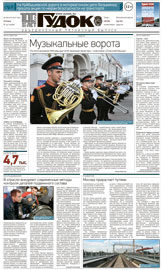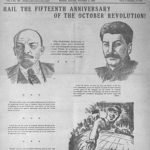Tag: Russia
Primary Sources: Gudok Digital Archive (1917-2017)
 The Library has acquired the Russian daily newspaper, Gudok, which has been in continuous publication since 1917 and is one of the country’s oldest and leading trade newspapers. Since its inception, it has covered a wide range of topics dealing with the railway industry. It has also provided critical commentary on Soviet and post-Soviet Russian culture, politics, and social life. Its primary purpose has been informing the general Soviet and subsequently Russian reader with the more substantial goings on in the country in combination with a mix of biting social commentary and satire, one of the newspapers most popular features.
The Library has acquired the Russian daily newspaper, Gudok, which has been in continuous publication since 1917 and is one of the country’s oldest and leading trade newspapers. Since its inception, it has covered a wide range of topics dealing with the railway industry. It has also provided critical commentary on Soviet and post-Soviet Russian culture, politics, and social life. Its primary purpose has been informing the general Soviet and subsequently Russian reader with the more substantial goings on in the country in combination with a mix of biting social commentary and satire, one of the newspapers most popular features.
Primary Sources: Moscow News Digital Archive
 The Library has recently acquired access to Moscow News (pub. 1930-2014), which, as described on the database platform, “was the oldest English-language newspaper in Russia and, arguably, the newspaper with the longest democratic history. From a mouthpiece of the Communist party to an influential advocate for social and political change, the pages of Moscow News reflect the shifting ideological, political, social and economic currents that have swept through the Soviet Union and Russia in the last century.
The Library has recently acquired access to Moscow News (pub. 1930-2014), which, as described on the database platform, “was the oldest English-language newspaper in Russia and, arguably, the newspaper with the longest democratic history. From a mouthpiece of the Communist party to an influential advocate for social and political change, the pages of Moscow News reflect the shifting ideological, political, social and economic currents that have swept through the Soviet Union and Russia in the last century.
“The Moscow News Digital Archive contains all obtainable published issues (1930-2014, approx. 60,000 pages), including issues of the newspaper’s short-lived sister publication Moscow Daily News (1932-1938).
“The Moscow News Digital Archive offers scholars the most comprehensive collection available for this title, and features full page-level digitization, complete original graphics, and searchable text, and is cross-searchable with numerous other East View digital resources.”
Resource: Russian National Bibliography
The Library recently acquired access through EastView to the Russian National Bibliography.
Included in the resource are: the definitive reference guide available to Russian book publications; indices to Russian journals, periodicals, and newspapers; book reviews found in the central and regional Russian press; synopses of dissertations from the Russian Federation; an index to Russian music-related publications; and an index of visual materials published or appearing in books, collected works, and magazines.
All of these can be searched separately or together. Use the Keyword search box to enter the keywords for your search. To the right of the Keyword search box you can select whether you want to conduct your search in Russian, English, or Transliteration. One thing to note here — by using English keywords for your search, your search will be on English-language sources only. If you want to run a search in Russian, but do not have a Russian keyboard driver installed in your system, click “Russian Keyboard.” A small window will pop up with a Russian keyboard that will enter the text you type on it directly into Keyword search box.
Primary Sources: Digital archives of two Russian magazines
The Library has recently acquired digital archives of two Russian magazines. The descriptions are taken from the vendor’s platform.
Niva (Grainfield in Russian), “an illustrated weekly journal of literature, politics and modern life was the most popular magazine of the late-nineteenth-century Russia. It was published from 1870 to 1918 in St.Petersburg. The journal was widely read by an audience that extended from primary schoolteachers, rural parish priests, and the urban middle class to the gentry. It contained large colored prints of art by famous Russian artists. It also had special children’s section as well as a section on Russian classical writers: Gogol, Lermontov, Goncharov, Dostoevsky, Chekhov and many others. By the early 20th century Niva had a circulation of over 200,000.”
Founded by the avante-garde group the “Left Front of the Arts”, Levyi front iskusstv (Lef) was published from 1923-1925. “In total, there were 33 issues, but that short print run inspired entire movements and artists not only in Russia, but throughout the world. The magazine’s pages were truly the battleground where formal experimentation was defended while Socialist Realism ascended. The Soviet era was in its infancy, and people were energized for the possibilities of the future, and these publications reflected the energy of the times. The journals were a forum for intense debate, including manifestos, polemics and critical articles on photography, film, theater, architecture, and design. This is where Sergei Eisenstein’s “The Montage of Attractions,” Isaac Babel’s “Red cavalry,” Vladimir Mayakovsky’s “About This” were first published. Other contributors included Dziga Vertov, Viktor Shklovsky, Nikolai Aseev, Boris Kushner, Sergei Tret’iakov, and more. The journal also championed photography and film as the most suitable forms for postrevolutionary art. The renowned artist and photographer Alexander Rodchenko designed the covers of twenty-four issues of the journal. Many of his photos with multiple viewpoints, tilted horizons, disorienting perspectives, and abstracted forms served as an alternative model for realism, challenging the grand, monumental style that was dominating official Soviet art.”
Resource: Russian Historical Statistics Online
I am passing on information about this new resource from Liladhar Pendse, our Slavic and East European Studies Librarian.
The International Institute of Social History in Amsterdam, the New Economic School (Moscow) and the Interdisciplinary Centre for Studies in History, Economy and Society (Moscow), have created an online database of historical statistics on the social and economic development of Russia over the last two centuries. The Electronic Repository of Russian Historical Statistics caters to the needs of the scholarly community, of teachers and students in the social sciences and humanities in higher education, and aims to provide the basis for an informed public debate on Russia’s past and present social and economic performance. Data are available online for all interested users, free of charge.
A unique aspect of the Repository is that it systematically provides data at the subnational, regional level, for the territory of the current Russian Federation. By systematically making available data with a regional breakdown the repository intends to further the development of regional perspectives on Russian history and enhance the integration of Russian cases in the rapidly evolving field of transnational history.
The data available from the Repository have been gathered on a standard programme, along seven principal lines of inquiry (population, labour, industrial output, agricultural output, services, capital, land) and for five cross-sections of Russian history (1795, 1858, 1897, 1959, 2002).
The project was funded by the Dynasty Foundation (Moscow) and the International Institute of Social History.
There is an English-language interface for choosing and downloading datasets, but the data and accompanying documentation is in Russian.
Primary Sources: Russian-German project to digitize German documents in the archives of the Russian Federation
The Russian Historical Society, the Ministry of Defense and the Federal archival agency, with support from the German Historical Institute in Moscow, are digitizing the large collection of Nazi Germany documents located in various Russian Federation government archives. The site is in Russian and German.
According to the project website description, the collections digitized so far include:
Collection of documents of German secret services 1912-1945. Russian State Archive of Socio-Political History (RGASPI, Fond 458, Series 9)
The collection includes dispersed folders originally formed in institutional archives of Germany, Austria, France and Poland. The documents were moved from Germany to USSR after the Second World War. During 1940’s-1960’s, the collection was transferred to the Central Party Archive of the Institute of Marxism-Leninism of the Central Committee of the Communist Party of the Soviet Union (currently the Russian State Archive of Socio-Political History) from the Central State Special Archive of the Main Archival Administration of the Council of Ministers of the USSR, General department of the Central Committee of the Communist Party of the Soviet Union and Ministry of Foreign Affairs of the USSR.
Main part of the collection consists of secret services’ surveillance reports of Komintern activities as well as other communist, social-democratic, labor, trade union, youth and other opposition organizations, movements and individuals in various countries.
German documents of the First World War. Central Archive of the Ministry of Defense of the Russian Federation (TsAMO RF, Fond 500, Series 12519)
Central Archive of the Ministry of Defense of the Russian Federation (TsAMO RF) received the collection of “German documents of the First World War” (Fond 500, Series 12519) from the Military Scientific Directorate and the General Staff of the Military Forces of the USSR during the period of 1953-1961. The collection includes 36,000 pages of institutional documents of German Great General Staff, staffs and chiefs of troops, military units, the Prussian War Ministry, Ministry of Internal Affairs, Ministry of Foreign Affairs and others.
The bulk of the collection includes war operations record books (84 folders), maps and schemas (146 folders), personnel files (85 folders), financial records and other documents. Also included are lists of military units and overview of their formation and deployment, records of weapons supply, chemical weapons use, information about damaged and sunken battleships, military propaganda materials and surveillance briefs.
The collection also includes materials about Germany’s foreign and internal affairs, the 1907 Second Hague Peace Conference, The Russo-Japanese War of 1904, peace treaty and economic negotiations with Romania.
Resource: Russian Politics Web Archive
In light of recent events in Russia, UCLA has published its latest collection of archived web pages on Russian politics. Among the pages are “captures of Boris Nemtsov’s blog and of the reports he researched and wrote about corruption and mismanagement at the highest levels of government. Nemtsov was a prominent opposition political leader who was killed last Friday not far from Red Square.” [source]
The archived sites are in Russian, but the interface is in English.

